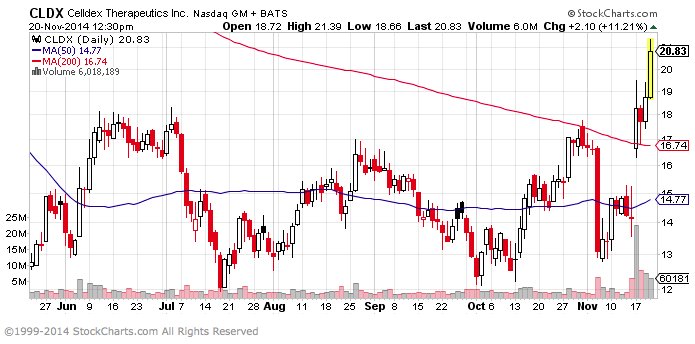Celldex Therapeutics (CLDX) has climbed 100% from all-time lows this summer – 40% in the last week – on encouraging and arguably groundbreaking results from a phase II study of its drug, rindopepimut, in brain cancer. The immunotherapeutic is meaningfully extending survival in patients with glioblastoma multiforme, an aggressive form of brain cancer. The positive data from this mid-stage study caught the Street off-guard, as did the company’s guidance that they may seek an accelerated approval from the U.S. FDA in the near-term.
Rindopepimut is designed to generate an immune response against certain EGFRvIII-expressing cells, which are found in about 25-50% of GBM patients according to existing medial literature. The phase II ReACT study, for which Celldex presented results on Friday at a medical conference, tests rindopepimut in EGFRvIIII-positive GBM patients who have recurrent disease but who had not yet received Roche’s (RHHBY) Avastin (bevacizumab).
The data demonstrate a statistically significant improvement in survival for patients receiving a combination of Avastin and rindopepimut compared to patients receiving Avastin alone: a 12.0 month median Overall Survival, vs an 8.8 month median OS (p=0.0208). A Hazard Ratio of 0.47 means patients receiving the combination had a 53% reduction in the risk of death. Additionally, progression free survival is also trending in favor of the combination. Meanwhile, in a cohort of patients previously treated with Avastin but no longer responding (Avastin-refractory) rindopepimut plus Avastin did not produce the same benefit.
The full dataset can be seen here.
Investors are bidding up CLDX for two reasons:
1) In a conference call that accompanied the data last week, Celldex indicated that due to the survival benefit seen in the trial, which was unexpected from a small and exploratory study, the company hopes to begin discussions with the FDA about accelerating the development and approval timeline. That could move forward the drug’s emergence on the market, and thus future cash flows.
2) Expectations were somewhat low for this GBM data. Now, investors and analysts are increasing the assumed probabiltiy of success for rindopepimut in EGFRvIII+ GBM (Roth, for instance, increased chance of success from 75% to 85%). Some 25-50% of GBM patients are EGFRvIII+ according to existing medical literature, putting the addressable market in the U.S. in the 5,000-patient range. With pricing in-line with similar, novel oncology therapeutics ($8-12K monthly), investors are getting more comfortable with the likelihood of rindo’s $300-500 million GBM opportunity in the U.S.





